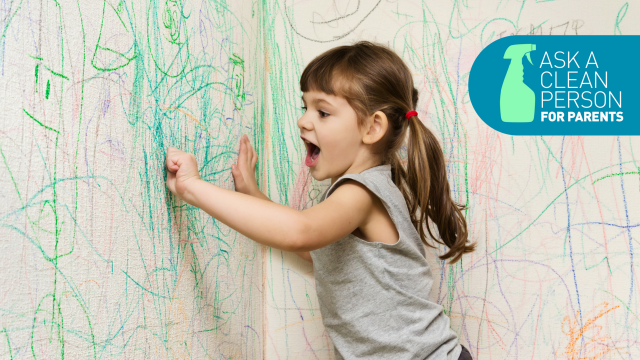Jolie Kerr is a cleaning expert, advice columnist and author of the New York Times bestselling book, My Boyfriend Barfed In My Handbag … And Other Things You Can’t Ask Martha. Her flagship column, “Ask a Clean Person”, debuted in 2011. Here on Lifehacker, we’re launching a new iteration of it, focusing on parenting and all the messes it brings.
Photo: AleksWolf/Shutterstock
I have a kid, he is three, he likes crayons. I am also a mum, I wash clothes, and ruined my favourite shirt. How can I salvage this orange crayon mess? The stain isn’t big – just on the edges of the shirt – but it’s noticeable since the shirt is white.
I come bearing good news: I have recently had two crayon victories. Let me tell you about them, so that my crayon victories may also be your crayon victories!
Removing Crayon from Upholstered Furniture
The first crayon victory happened at a friend’s apartment. Her daughter had gotten scribbly on the couch, and so in between playing tea time and aeroplane, my friend asked if I could figure out how to get the scribbles out of the upholstery.
The solution was so easy I almost feel like I’m cheating you out of a more novel answer, but it is what it is: Diluted liquid laundry detergent took the crayon out of the upholstery. I know! That was really all it took, but let me explain the technique and specific detergent that we used. The detergent was Tide Ultra Stain Release, which is very, very good stuff. Other liquid detergents, or even dishwashing liquid, can be used for this, so don’t feel that you need to run out and import this specific formula.
To use it to take the crayon out of the couch, we poured a small amount – probably about a quarter teaspoon – of the liquid detergent into the bottle’s cap, and then filled it about halfway up with water. Then, using a light-coloured dish rag (using a light-coloured rag or sponge is important, so that you don’t end up transferring dye onto the area you’re trying to clean), we scrubbed at the crayon and it just came right off. To finish up, we rinsed the rag, wrung it out, and went over the area with clean water to remove the detergent residue.
Removing Crayon from Clothing
Shortly after that first crayon victory, a woman tweeted at me after having sent a crayon through the washer. Because the success with the couch was so fresh in my mind, I suggested she try soaking the stained clothes in hot water and Tide Ultra Stain Release for about an hour and then re-laundering them. The reason for the hot water, in this case, was to help, essentially, melt the wax from the crayon to loosen it up.
And that worked perfectly for her! So there you have it, fear not the crayon!
Removing Crayon from Walls and Floors
There will for sure be bigger, badder crayon messes to tackle in this column, but before we close this one out, it’s worth detouring to talk about getting crayon off of walls, floors and other hard surfaces.
Minor scribblings will, in all likelihood, wipe off with a small amount of dishwashing liquid and a sponge or rag, but if they prove to be too stubborn for detergents, there are bigger guns on which to call.
[referenced url=”https://www.lifehacker.com.au/2012/05/use-mayo-to-clean-crayon-art-from-your-walls/” thumb=”https://img.gawkerassets.com/img/17nazxfyra09yjpg/original.jpg” title=”Use Mayo To Clean Crayon ‘Art’ From Your Walls” excerpt=”If you have a little one who loves to play Picasso all over your walls in crayon, the fix may be as close as your fridge. Grab the mayonnaise, we’re going to work.”]
The first is the Magic Eraser, which are sponges made from melamine foam. To use them, get the sponge wet, wring out well, and rub on stained surfaces. When working with a Magic Eraser test it in an inconspicuous place to ensure it won’t cause damage to the surface in need of cleaning.
The second is WD-40. Man, WD-40 is just so righteous. To use it to remove crayon from hard surfaces, spray the crayon-ed area, then let the WD-40 stand on the wax for a minute or two to let the product do the work for you. Then, wipe it away using a rag, sponge or paper towels, and follow by wiping the area with a small amount of dishwashing liquid to remove the WD-40 residue.
Now let’s all get out there and have some crayon victories!

Comments